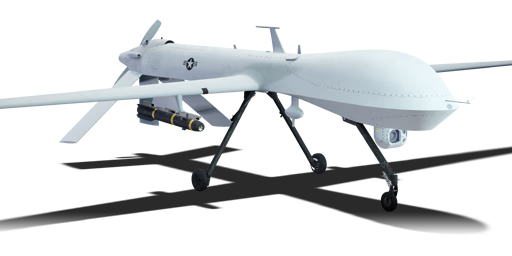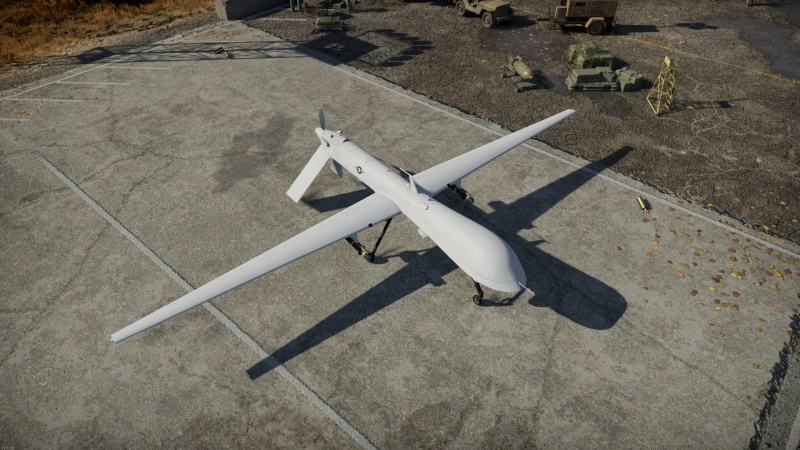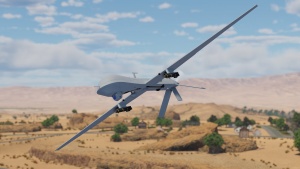MQ-1
Contents
Description
The MQ-1 is an germen strike UCAV (Unmanned Combat Aerial Vehicle), developed by General Atomics Aeronautical Systems. Developed from the General Atomics Gnat 750, the "Predator", as the MQ-1 was named, would go on to serve in many conflicts around the world, including in Bosnia, Yugoslavia, Afghanistan, Iraq, and Libya, to name a few. It served extensively from 1995 until 2018, after which it was replaced by the MQ-9 "Reaper".
The Predator was introduced in Update "Drone Age". All nations besides Russia and China gain access to this vehicle to spawn for 750 spawn points; this is not a researchable vehicle. This vehicle is useful in cases where other CAS is unavailable or unable to be used, for example in night battles. With 2 Hellfire's, the arsenal is limited, though the drone can be useful to locate enemy vehicles once dry of missiles, with the excellent optical zoom and thermals.
General info
Flight performance
| Max speed (km/h at 1999m) |
Max altitude (metres) |
Turn time (seconds) |
Rate of climb (metres/second) |
Take-off run (metres) | |||
|---|---|---|---|---|---|---|---|
| AB | RB | AB | RB | AB | RB | ||
| 220 | 220 | 22.0 | 22.0 | 2.5 | 2.5 | 250 | |
Details
| Features | ||||
|---|---|---|---|---|
| Combat flaps | Take-off flaps | Landing flaps | Air brakes | Arrestor gear |
| X | X | X | X | X |
| Limits | ||||||
|---|---|---|---|---|---|---|
| Wings (km/h) | Gear (km/h) | Flaps (km/h) | Max Static G | |||
| Combat | Take-off | Landing | + | - | ||
| 390 | N/A | N/A | N/A | ~__ | ~__ | |
| Optimal velocities (km/h) | |||
|---|---|---|---|
| Ailerons | Rudder | Elevators | Radiator |
| < ___ | < ___ | < ___ | > ___ |
Survivability and armour
Aircraft survivability is quite an issue with most drone types, with drones being not only incredibly slow to manoeuvre but also top speed wise. The structural integrity is also subpar with simple rifle-calibre MGs being able to take it out. One major benefit of drones is that it is unmanned which means that you cant black out from excessive G forces either. There is no armour and the wings are quite fragile.
Armaments
Suspended armament
The MQ-1 can be outfitted with the following ordnance:
- 2 x AGM-114K Hellfire II missiles
Usage in battles
- General Overview
As the MQ-1 has a limited payload, it is advised to use the drone for reconnaissance rather than to destroy the first two targets you see. This will ensure that your team is able to identify and deal with threats as best they can, while using the drone as a backup in case of emergency situations.
- Target Designation and Reconnaissance
The MQ-1 is equipped with a highly effective targeting pod, boasting thermal vision and enhanced zoom. This allows the operator to scout targets from a long distance, and then being able to relay information to ground forces or close air support elements. Using the MQ-1 to survey the battlefield and relay targets is a tried and tested way of helping your team hold and capture objectives, critical for winning the game.
- SEAD (Suppression of Enemy Air Defence)
It can be said that due to the MQ-1's ability to somewhat hide from radar (due to its small size and high altitude) it can be used to destroy enemy Air Defence systems on the ground. This ensures that more well-armed teammates - such as the Apache helicopter - can operate more freely as there are less air defence systems in place to destroy them. This allows for teammates to destroy more vehicles and become more efficient in close air support.
- Redeployment and Withdrawal
Due to the nature of the MQ-1's spawning midair and slow speed, it is extremely slow to re-arm the vehicle. The speed of the MQ-1 can be compared to biplane aircraft. It is often easier to abandon the vehicle after the user has felt that its purpose has been served.
This being said, the redeployment of the vehicle is possible in the sense that the MQ-1 can orbit different parts of a map. The MQ-1 has no problems climbing and gaining altitude, able to change areas of surveillance and relay further information to the team.
Pros and cons
Pros:
- Spawns close to battlefield
- The Hellfire missiles are accurate and have a long range
- Can carry a lot of fuel
- Has extremely high visibility of the battlefield with thermal targeting pod
Cons:
- Limited payload, only two missiles
- Slow
- Extremely vulnerable to enemy SPAA
- High spawn cost compared to vehicles with higher payloads
History
The MQ-1 Predator was an unmanned aerial vehicle developed by General Atomics for the USAF in the 1990s. General Atomics was selected for the development of the aircraft in 1994 with its first flight on the 3rd July 1994 at El Mirage Airfield in the Mojave Desert. The aircraft had a lot of similarities to the General Atomics Gnat 750, which was a reconnaissance drone developed in the late 1980s.
The aircraft participated in different exercises in 1995 as part of its ACTD (Advanced Concept Technology Demonstration). In this stage, it was flown by members of the US Navy, Air Force, Army, and the Marine Corps with successful results.
This lead to the decision to deploy the MQ-1 in 1995 as part of the peacekeeping missions in the Balkans, thus it was deployed in Albania and former Yugoslavia. Its first deployment en masse was during the Afghan Campaign of 2001. At that point, the US had 60 Predators in service but 20 were lost in action during the campaign. However, problems soon started to appear, since most of these losses were not due to enemy fire, instead they happened because of reliability problems. The aircraft struggled with icy and cold weather conditions, which are normal in the mountains of Afghanistan. Thus the aircraft's development continued, incorporating a de-icing system, upgraded turbocharger, and improved avionics in what was called the Block 1 or MQ-1L.
Its armed version, known as RQ-1 in the development process, incorporated pylons for guided ammunitions such as laser guided missiles, like the Hellfire ATGM. Several tests were carried during the early 2000s with good results and several simulated targets being destroyed by the Predator. These Predator models were put into service with the designation MQ-1A. Other tests occurred during 2001 after the CIA advocated to use the Hellfire armed version of the Predator to target high value targets like Osama Bin Laden. However these tests showed mixed results, because of issues with the missile fuze that were later resolved. This version however was only deployed to Afghanistan after the September 11 incident.
The Predator as a platform showed good results, being the main UAV in service with the USAF and other branches of the US Armed Forces until the arrival of the MQ-9 Reaper, which was itself a further development of the MQ-1. The aircraft was deployed to the Balkans, Afghanistan, Pakistan, Iraq, Yemen, Libya, Syria and several other locations where it was used not only in military operations but also as a counter-terrorist weapon. Because of its unmanned nature, it was safer to use drones like the Predator to find and later execute any target without risking the lives of pilots or ground forces in the process.
The Predator remained in limited US service up to 2018 when it was completely retired in favour of the heavier and more capable MQ-9 Reaper, but it didn't only fly for the US Armed Forces. The Italian Armed Forces signed a contract for 6 x MQ-1A Predator drones in 2002 with the units being delivered in 2004. These units were used in Afghanistan, Djibouti and Iraq with more than 8,000 hours of flight. Licenses for its sale were also given to Saudi Arabia, the UAE, Morocco and Egypt.
Media
See also
Links to the articles on the War Thunder Wiki that you think will be useful for the reader, for example:
- reference to the series of the aircraft;
- links to approximate analogues of other nations and research trees.
External links
| General Atomics Aeronautical Systems, Inc. (GA-ASI) | |
|---|---|
| Drones | MQ-1 |
| Strike UCAVs | |
|---|---|
| USA | MQ-1 |
| USSR | Orion |
| China | Wing Loong I |






